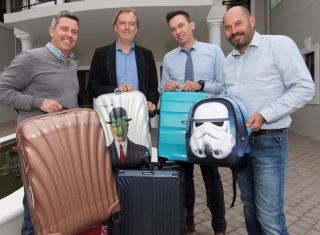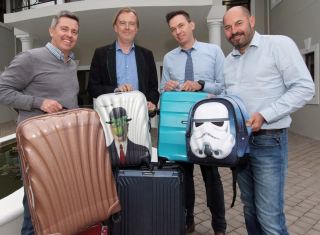Luggage is getting smarter says Samsonite
Today’s world is in a state of perpetual motion – and luggage is getting smarter, stronger and lighter, according to Samsonite Europe President, Arne Borrey on a recent trip to South Africa.
As the world’s largest travel luggage company, Samsonite has a legacy of trendsetting travel solutions. “Brand loyalty is import but what’s also crucial is how well brands fulfil the needs of consumers. Samsonite has the incredible strength of research and development behind its brands. Out of the 10 innovations in luggage over the past 15 years, we’ve had nine. As a result, investment in development has yielded products that are strong and light - and that’s what the consumer wants.”
Proof of that is Samsonite’s revolutionary Curv® material which is exclusive to the brand.
This next generation composite is made from highly drawn polypropylene rather than the conventional polypropylene favoured by its rival brands and unites the functional versatility of thermoplastics and the impact-resistant performance of a fibre-reinforced composite.
Five times stronger than conventional materials, it delivers a suitcase that is light and durable, has high impact resistance even at low temperature and is less sensitive to scratches and damage.
“We have invented this new market segment of pressure formed woven polypropylene that sells well in South Africa. If you a long haul traveller, you want to be really sure about the protection of your goods. Curv based products like Samsonite’s Cosmolite collection are perfect for that,” he said.
Borrey said that the starting point for Samsonite’s innovation team was unpacking exactly what consumers wanted.
“You have to understand trends and stay ahead of them – and then you also need to drive the trends. For starters, we need to know how fast a consumer will replace his or her suitcase. Millions of our suitcases were sold during the nineties. Because they are strong and well made, people could still travel with them. The big question is, do they want to? Technology and fashion have evolved and they want different shapes and forms now,” he explained.
Innovations could soon come to market include built in scales that will tell the traveller how much a suitcase weighs or a capacity meter that would indicate whether a half, a third or all of the volume has been utilised.
Telemetry tags will help solve the perennial bugbear of lost suitcases.
According to Borrey, in 2015, 23.1 million pieces of baggage were mishandled (either temporarily or permanently lost) worldwide.
Earlier this year, Samsonite announced that it was working closely with Vodafone to develop an innovative luggage tracking solution called Track&Go™. The technology partners are currently trialling a new longer battery life, wider range technology called Narrowband-IoT (NB-IoT) that can be easily and privately tracked by its owner.
This Track&Go solution is based on two principles - proximity alerts and geolocation. A traveler instantly receives a smartphone notification when a bag moves out of range. This is ideal for cruise, bus or train passengers wishing to leave their suitcases in a compartment. If a bag is lost, a traveler will be able to see its current location so that it can be traced.
TUMI, a top end luggage brand that Samsonite acquired in August 2016, will take this into the air travel arena.
Borrey said that he is currently travelling with a Tumi luggage locator that will launch later this year. This informs the passenger whether a suitcase has been loaded on to a plane. When the plane takes off, the acceleration turns the device off. On landing, the deceleration reactivates the device.
“You have to give your suitcase a name online. It then sends you a message to say that it has arrived at the destination,” he said.
He added that there was growing stream of innovation in the luggage space - including power assisted wheels similar to those used on bicycles.
“If you look at the business traveller, one of the worst things that can happen is to not have enough power for your tools. Suitcases and laptop bags could have built in solar panels or power packs so that you can charge your phone or your laptop. We are looking at how you could put solar panels or power banks inside business bags without making them too expensive and too heavy.”
Borrey said the jury was still out on what innovations consumers would find most useful.
But one thing’s for sure – all new innovations will be sensitive to safety and security and comply with all airline regulations. He said that Samsonite worked closely with bodies such as IATA to ensure the best possible solutions.
When it comes to aesthetics, Borrey said Samsonite was going all out to solve the ultimate business traveller challenge – creating a business bag for the growing number of female executive that are travelling between boardrooms.
“Even today, we still sell mostly male oriented business bags. Many women put their computers in their handbags. That makes them awfully heavy and they’re not make for that,” he noted. Meanwhile, Samsonite has just launched a stylish range of women’s business cases – Zalia by Samsonite. More business cases for women are coming – especially now that the TUMI brand was on board, he added.
Another important new trend is the personalisation of luggage. TUMI shops worldwide – including the one in Johannesburg – allow customers to put their initials or symbols on their luggage and bags. They choose the font and the colour and it is done in store as an incentive to purchase.
For more information, visit www.houseofsamsonite.co.za
SA luggage market set to grow says Samsonite Europe president
More and more South Africans are travelling – and investing in state-of-the-art branded luggage. This will pave the way for Samsonite South Africa to more than double sales within the next five years.
That’s according to Arne Borrey, president of Samsonite Europe, who recently visited South Africa.
It has been eight years since he played an instrumental role in creating Samsonite South Africa, a joint venture between the world’s largest travel luggage company and local partners, Tom O’Flaherty and Rob Kunze.
He is proud of what has been achieved. The local arm of the company has grown six fold since 2009 and increased its staff tenfold.
His South African trip is to not only chart the way forward but to bed down the local transition of the international takeover of premier luggage brand TUMI which Samsonite International acquired in August last year.
Globally, the group’s total sales increased by 17.3% to US$ 2,810.5 million during the year ended December 31, 2016. This followed a 36,7% increase in North America, a 4,7% increase in Latin America, a 22% increase in Europe and a 36,7% increase in Asia.
2017 looks set to be an even better year. Over the long-term, global tourism is estimated to grow by 3.3% annually from 2011 to 2030. The worldwide luggage market is forecast to grow at an annual rate of 6.1% between 2017 and 2021.
He says that the Samsonite management team will continue to develop the group into a diversified, multi-brand, multi-category and multi-channel luggage, bag and accessories business, offering customers a competitive mix of products sold through multiple distribution channels.
Although times are tight in South Africa, travel is also still expected to increase. A study by Grant Thornton International published in January 2017 shows that South Africa’s outbound tourism has grown by 6,2 percent between 2006 and 2015 and is set to continue to accelerate.
Last year, 5.5 million locals travelled. Of these, 300 000 were leisure travellers.
But it is the potential travellers that have Borrey’s attention. According to the study, 860 000 individuals – or 3 percent of the population – can afford to take holidays. That’s double plus current figures.
“Here, we are aiming at a growing emerging middle class. There is a core of people that travel a lot in this country and know our brands. We knew that would be a good foundation for the business. But the people that will take us to the next level will be the emerging middle market that is just starting to discover travel. They want to go abroad and also have business travel needs that we can meet with all kinds of products,” he explains.
In South Africa, the company has a number of brands – Samsonite which targets the higher end travel and business market, American Tourister, which is more affordable and appeals to the younger traveller, fashion focused Lipault luggage and handbags and TUMI which appeals to the very top end of the travel market.
Samsonite, which has been in South Africa for 19 years, remains the market leader. American Tourister, which was virtually non-existent at the time of the joint venture, now features within the top four luggage brands in South Africa and accounts for between 20 and 30 percent of local business.
South Africa was one of three joint ventures that Samsonite entered into in 2009. “At that point in time, South Africa, Russia and Turkey were the three most promising emerging markets within our portfolio. I believe that, had we not partnered with those local entrepreneurs who both knew the Samsonite brand and their own markets very well, we would have failed.”
Over the years, these three markets have performed differently. The growth of the middle class has been quicker in Russia and Turkey. “As a result, the growth potential in South Africa is somewhat larger than in markets such as Turkey where the penetration of our products has been much bigger over the past 10 years,” he says.
Another difference is that, up until now, Samsonite South Africa has grown on the back of outbound travel. In Turkey, there is a great deal of inbound tourism from the likes of Europe and Asia. These tourists come to shop.
This is only now beginning to emerge in South Africa. With increased numbers of inbound passengers, particularly from North Africa, Samsonite is beginning to see increases in sales, particularly in Gauteng.
Borrey, who is responsible for the overall strategic planning and for managing the Group’s operations across Europe, is an expert in business development.
Borrey believes it’s time to completely re-think luggage retailing in South Africa which he believes remains “stuck in the seventies”.
“When you walk into many luggage and leather goods stores here, you often see a wall of products which can be overwhelming. That’s not the way of the future which will be about visual merchandising and creating a memorable retail experience. With luggage, there has to be a personal connection and we want to provide that,” says Borrey.
Currently, the company’s products are sold via more than 100 specialised luggage outlets and 60 mass market stores. Samsonite South Africa has seven of its own corporate stores, including a factory outlet and a TUMI store in Johannesburg which officially moved under the Samsonite group’s banner this month.
The local online offering launched in November 2016.
He expects Samsonite’s concept stores to lead the way. Each one will be more than “just another luggage shop”, occupying a similar space to designer clothing boutiques and branded electronics outlets.
Two Samsonite stores – the new Nicolway store in Johannesburg and the Tygervalley store in Cape Town – have already been completely remodelled into new age stores.
“This will definitely lift the brand. When people walk in, they will realise that the environment says we’re different, we’re world class. We need to offer the consumer new ideas. If you have stores in right location, a consumer will come in every two to three months. So, they need to see something new, something interesting.” In South Africa, retail channels will also be closely aligned with online channels as they are in Europe.
For more information, visit www.houseofsamsonite.co.za



